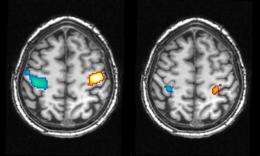Brain imaging study: A step toward true 'dream reading'

When people dream that they are performing a particular action, a portion of the brain involved in the planning and execution of movement lights up with activity. The finding, made by scanning the brains of lucid dreamers while they slept, offers a glimpse into the non-waking consciousness and is a first step toward true "dream reading," according to a report published online in the Cell Press journal Current Biology on October 27.
"Dreaming is not just looking at a dream movie," said Martin Dresler of the Max Planck Institute of Psychiatry. "Brain regions representing specific body motions are activated."
Lucid dreamers are aware that they are dreaming and can deliberately control their actions in dreams. The researchers realized that this learned skill presents an opportunity for studying the neural underpinnings of our dreams.
"The main obstacle in studying specific dream content is that spontaneous dream activity cannot be experimentally controlled, as subjects typically cannot perform predecided mental actions during sleep," study coauthor Michael Czisch explained. "Employing the skill of lucid dreaming can help to overcome these obstacles."
The researchers instructed participants to make a series of left and right hand movements separated by a series of eye movements upon entering a lucid dream state while their brains were scanned. Those eye movements served as a signal to the researchers of what was happening in the dream.
Those studies show for the first time that neural activity observed in the brain's sensorimotor cortex can be related to dreamed hand movements.
The discovery suggests that lucid dreaming in combination with neuroimaging and polysomnography (a more common form of sleep monitoring) may allow the transfer of more sophisticated "brain reading" tasks to the dreaming state, the researchers say. In other words, it might eventually be possible to predict dreamed content by analyzing patterns of brain activity.
Dresler says it will also be interesting to investigate brain activity at the moment a dreamer becomes lucid.
"The lucid dreamer gains insight into a very complex state: sleeping, dreaming, but being consciously aware of the dream state," he said. "This may inform us about concepts of consciousness."












